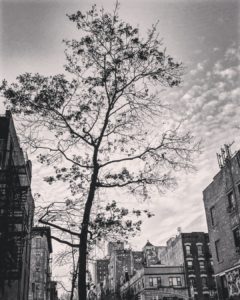 There always seemed to be overcast skies with a greyish hue that placed a gritty film over everything in sight. The drug dealers selling crack and other drugs on the street corners would wear dark colored camouflage, despite police officers seemingly never being around, as they didn’t want to take the chance of being too in the cops’ faces as they shouted out, “crack, crack, smoke, smoke”. Although everything seemed gloom and doom, there was very little time to get noticeably depressed as there was an electricity in the air that was rooted in many things: fear of getting attacked while walking down the street, fear of not making enough money for rent and ending up on the street, and oddly, the elation that came from witnessing a rare piece of music, art, or performance that was not there to charm tourists out of their money as no one but the poor residents, and visitors who wanted to score drugs, would hang around such a place… these artistic expressions were created by lost, broken humans whose souls cried out to connect.
There always seemed to be overcast skies with a greyish hue that placed a gritty film over everything in sight. The drug dealers selling crack and other drugs on the street corners would wear dark colored camouflage, despite police officers seemingly never being around, as they didn’t want to take the chance of being too in the cops’ faces as they shouted out, “crack, crack, smoke, smoke”. Although everything seemed gloom and doom, there was very little time to get noticeably depressed as there was an electricity in the air that was rooted in many things: fear of getting attacked while walking down the street, fear of not making enough money for rent and ending up on the street, and oddly, the elation that came from witnessing a rare piece of music, art, or performance that was not there to charm tourists out of their money as no one but the poor residents, and visitors who wanted to score drugs, would hang around such a place… these artistic expressions were created by lost, broken humans whose souls cried out to connect.
Lower East Side (LES)
The place I’m talking about is Alphabet City in the East Village of New York City -specifically B & C Avenues in the 1990s – my home from 1993 until 2004. I still live within walking distance and find myself there a couple times a week, yet many times when I am in my old neighborhood, I am furiously running around trying to get everything done with all that I juggle as a freelancer, so there is never much time for nostalgia… until a little over a month ago. I felt a pull to wander farther east, into the heart of my old ‘hood that still has many of the run-down tenement apartments (slums originally created for the poor immigrants flooding into NYC back in the early 1900s), and my heart started to ache for my previous home… I ached for all the creativity that surrounded me back in those times… witnessing some of the most amazing performances from people, like myself, who didn’t have enough money to eat on a daily basis let alone buy materials. Scavenging the streets and garbage cans was where many of us found the items to work with… many times what we gathered from the street was not ideal but it would not stop us from creating and performing… in many ways, it made us even more inventive.
 A couple weeks after allowing myself to walk down memory lane, I watched the last episode of Anthony Bourdain: Parts Unknown, which was filmed in the Lower East Side (LES), my old neighborhood being showcased at certain points. It is interesting to note that although the LES does not technically include the East Village, the Alphabet City section of it that was part of the whole artist scene from the 70s until the 90s was connected to part of the Lower East Side; actually one can draw a completely different map that takes parts of the East Village and parts of the LES to create the area where artists, drug addicts, murderers, and solid blue-collar people all struggled together in this lower income neighborhood. I ended up there by chance as an 18 year old with no family, no home, no sense of how to navigate my life, except that I loved to read and I loved to create and NYC gave me the ability to do both… initially I lived in the YMCA and then I found my way to Alphabet City.
A couple weeks after allowing myself to walk down memory lane, I watched the last episode of Anthony Bourdain: Parts Unknown, which was filmed in the Lower East Side (LES), my old neighborhood being showcased at certain points. It is interesting to note that although the LES does not technically include the East Village, the Alphabet City section of it that was part of the whole artist scene from the 70s until the 90s was connected to part of the Lower East Side; actually one can draw a completely different map that takes parts of the East Village and parts of the LES to create the area where artists, drug addicts, murderers, and solid blue-collar people all struggled together in this lower income neighborhood. I ended up there by chance as an 18 year old with no family, no home, no sense of how to navigate my life, except that I loved to read and I loved to create and NYC gave me the ability to do both… initially I lived in the YMCA and then I found my way to Alphabet City.
I never got into drugs – not even marijuana (but that may be reconsidered once cannabis becomes legal in New York) – and there was a time that I didn’t even drink alcohol. It wasn’t because I had a holier-than-thou attitude but it is because I came from parents, who luckily wanted very little to do with me, that were a combination of alcoholics and drug addicts. When you come from such a background, typically one of two things happens: you either become an addict yourself, or you never touch any type of drug (for many years, I was even against taking over-the-counter medicine such as aspirin). But through time, I fell in love with wine before I even started to consume it… for a geek like me, it had everything: science, history, geography, culture and most importantly, a sense of connecting to a community, to many communities around the world as I was surrounded by poor artists who came from around the globe and they shared the wines from their homelands.
There was a group of us who decided to save up during the week to be able to splurge on a bottle to share with different people from around the world, with everyone taking turns. Many times I only ate potatoes during the week, a habit that I still continue to this day funnily enough, so I could save enough money to pay my fair share. I would dream about the bottle, reading as much as I could about the area of production in books at the library in anticipation of what I was going to drink with my struggling artistic wine group that week… and I will never forget the week that I first tasted gold.
Golden Bordeaux
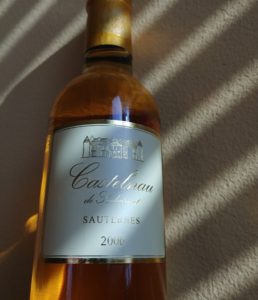 I was one of those weird kids who was not a big fan of sweets… I mainly went crazy for salty, fatty, umami qualities – I think that is why I loved Chinese food with lots of MSG. And so I was certainly skeptical of my pauper-ish band of artisans spending our hard-earned money on a sweet wine named Barsac – the area that encompasses one of the most famous sweet wine areas, Sauternes in Bordeaux, France (side note: all Sauternes are Barsac but not all Barsac are Sauternes). Well, I was amazed by its complexity of spice, umami represented by mushrooms and truffles, array of sweetness from coconut to marmalade, a bouquet of mixed flowers and a range of minerality that I had not yet learned the words to express. Then, over the next few weeks, we really sacrificed to be able to get a bottle of Sauternes, which blew our minds to another level. After that, I started the process of reading about other sweet wine areas near Sauternes and Barsac and even though it would take many years before entering the wine business when I would be given a chance to taste a parade of these golden delights, I dreamt of them all the time and those dreams helped me to get through many tough times.
I was one of those weird kids who was not a big fan of sweets… I mainly went crazy for salty, fatty, umami qualities – I think that is why I loved Chinese food with lots of MSG. And so I was certainly skeptical of my pauper-ish band of artisans spending our hard-earned money on a sweet wine named Barsac – the area that encompasses one of the most famous sweet wine areas, Sauternes in Bordeaux, France (side note: all Sauternes are Barsac but not all Barsac are Sauternes). Well, I was amazed by its complexity of spice, umami represented by mushrooms and truffles, array of sweetness from coconut to marmalade, a bouquet of mixed flowers and a range of minerality that I had not yet learned the words to express. Then, over the next few weeks, we really sacrificed to be able to get a bottle of Sauternes, which blew our minds to another level. After that, I started the process of reading about other sweet wine areas near Sauternes and Barsac and even though it would take many years before entering the wine business when I would be given a chance to taste a parade of these golden delights, I dreamt of them all the time and those dreams helped me to get through many tough times.
 Back in November, I was sent 8 samples of golden sweet Bordeaux wines from Snooth as they were promoting these wines, many from tiny wine producers that never had the means, before social media, to get the word out, to be tasted alongside a video seminar they launched on their site. Not only did the Snooth video about these golden beauties address the extreme nature of farming and making these wines that involves several harvest passes (picking grape by grape) and the minuscule yield that comes from grapes that are blessed by noble rot, but they addressed the idea that these wines were not only meant to be drunk with fine food but paired very well with everyday salty, fatty and crispy delights such as fried chicken – a fantastic recommendation from Mary Gorman-McAdams MW, who co-hosted the video with Snooth.
Back in November, I was sent 8 samples of golden sweet Bordeaux wines from Snooth as they were promoting these wines, many from tiny wine producers that never had the means, before social media, to get the word out, to be tasted alongside a video seminar they launched on their site. Not only did the Snooth video about these golden beauties address the extreme nature of farming and making these wines that involves several harvest passes (picking grape by grape) and the minuscule yield that comes from grapes that are blessed by noble rot, but they addressed the idea that these wines were not only meant to be drunk with fine food but paired very well with everyday salty, fatty and crispy delights such as fried chicken – a fantastic recommendation from Mary Gorman-McAdams MW, who co-hosted the video with Snooth.
Treasures for the Downtrodden
 Tasting through the snack pack sent by Snooth to pair with the wines, I found that the spicy beef jerky and Calabrese salami were my favorites and the whole experience made me flash back to some of my more precious wine working times in Bordeaux… going to visit a tiny sweet wine producer for dinner where a ham that was cooked buried in the ground was served to us, a lunch that paired Sauternes sweet wines with spicy Szechuan food where the producer of a small winery nervously sat at my table wringing her hands not knowing what to expect as she had never previously eaten Szechuan food (at the end it shocked us all how well these foods went with each other) and all the times that my former group of artists gathered on the floor of someone’s apartment with potato chips, Doritos and cheap cheeses and meats – anything we could afford that would create a poor person’s feast to go with these wines.
Tasting through the snack pack sent by Snooth to pair with the wines, I found that the spicy beef jerky and Calabrese salami were my favorites and the whole experience made me flash back to some of my more precious wine working times in Bordeaux… going to visit a tiny sweet wine producer for dinner where a ham that was cooked buried in the ground was served to us, a lunch that paired Sauternes sweet wines with spicy Szechuan food where the producer of a small winery nervously sat at my table wringing her hands not knowing what to expect as she had never previously eaten Szechuan food (at the end it shocked us all how well these foods went with each other) and all the times that my former group of artists gathered on the floor of someone’s apartment with potato chips, Doritos and cheap cheeses and meats – anything we could afford that would create a poor person’s feast to go with these wines.
We may have been downtrodden back then but we did, in many ways, get so much out of life… no one was there to compete, show off knowledge, make anyone else jealous, or even knew the words “trophy wines.” We were there to share, to learn, to be enlightened, to be part of something special. Just like all the downtown theater that was prevalent during my time, it was not about being a star – you went to midtown in NYC or LA for that – it was about finally belonging, about finding other broken beings who just wanted to do something good with the volcano of emotions and images that plagued their minds, hearts and souls.
 It was a little painful to watch Tony Bourdain revisit the Lower East Side because you could see in his eyes that he desperately wanted to go back to the old days and that too much had changed… just like for myself and for so many others, that time no longer exists… only bits and pieces of that creativity can be found there now. But change is a part of life and it sure as hell is a part of New York City; you need to find a way to keep moving and evolving with it. And let’s not kid ourselves, there was a lot of bad going on back in those days… I do not miss fearing for my life every time I walked down the street or seeing prostitutes every damn day or drug addicts shooting up. Yes, it is still there, but not so much in your face.
It was a little painful to watch Tony Bourdain revisit the Lower East Side because you could see in his eyes that he desperately wanted to go back to the old days and that too much had changed… just like for myself and for so many others, that time no longer exists… only bits and pieces of that creativity can be found there now. But change is a part of life and it sure as hell is a part of New York City; you need to find a way to keep moving and evolving with it. And let’s not kid ourselves, there was a lot of bad going on back in those days… I do not miss fearing for my life every time I walked down the street or seeing prostitutes every damn day or drug addicts shooting up. Yes, it is still there, but not so much in your face.
Making Gold
At the heart of many of these golden sweet wines is the process of botrytis that is common in certain wine growing areas in Bordeaux because of the confluence of two bodies of water, one warm and one cold, that creates a mist in the morning that is ideally balanced by the sun coming out during the day to dry the damp grapes. While some of the grapes can quickly turn into bad rot that cannot be used for the golden wine, others slowly shrivel to perfection as microscopic spores find their way through the skins of the grapes without breaking them, concentrating the sugars and altering flavors, bringing complexity.
I am grateful that I came to wine and discovered the artist within myself in Alphabet City back in the 90s – especially storytelling – although I must admit that I was probably one of the least creative people in my old neighborhood. I think my desire to learn, as well as being surrounded by those who amazed me at every turn helped me to see the world in a different way. But many of those people paid a price, whether it was damage from expanding their minds with major drugs or ending up on the street because of insane amounts of debt that was incurred by making spaces available to artists such as myself… it was a constant balancing act of being part of a beautiful, yet in some ways, toxic community, just like how producers need to find balance grape by grape, sorting between the ones destined for a divine sweet wine and those that are simply rotten and are to be thrown away – each of us has the capacity for noble or bad rot and each day our choices lead us to one or the other.
The Art that Lives within Us
 To me, the most precious moment of Bourdain’s LES episode was finding out who was the person(s) who made captivating mosaic art on lamp posts all over the East Village – it was one man named Jim Power, who was mainly unknown, because his intention, as he explained, was to bring beauty to the struggling
To me, the most precious moment of Bourdain’s LES episode was finding out who was the person(s) who made captivating mosaic art on lamp posts all over the East Village – it was one man named Jim Power, who was mainly unknown, because his intention, as he explained, was to bring beauty to the struggling
residents, and I have to say that on many an occasion while walking home from balancing working a couple of jobs in order to survive, while sadly witnessing the depravity on the streets, I would turn and see one of his mosaics (not knowing if it was one or many people doing them) and smile with hope reignited in my heart. It was the most precious part because it represented everything that was good about that time that not only still remains on some old lamp posts they reinstalled but that still resides inside of me.
My challenges are different these days but can be just as overwhelming at times. Some people want to suck you into their world of jealousy, competition and elitism with wine and that really has very little to do with the good parts of it and has nothing to do with why I got into it. Many of these small Bordeaux producers making sweet wine are artistic farmers committed to an extreme practice of making liquid gold because they have been given a gift and a curse at the same time. They take on all the challenges because the grapes’ souls cry out, just like so many of those people I have known in the past, to express a wine that is deeper, richer and much more complicated than the easier route of not making noble rot wine. They continue the fight and struggle to find a place for these wines in an ever changing world just like I am trying to carry the torch of all those who introduced me to wine – people who were so much more brilliant and talented than I, yet for some reason, I am one of the few still standing, and because of that I have a responsibility, just like these golden wine producers. I was given a gift that may not have seemed like one at the time, and instead of mourning its loss, I now need to find a way to keep the essence of it alive.
****************************************************************************
#GoGoldenBordeaux Sweet Wines Tasted on November 7th, 2018
***Quick Helpful Note: The below sweet wines can be placed in the fridge for about a week with either the cork back in, or better yet, a bottle vacuum sealer, and in some cases these wines may last up to a couple weeks. All the sugar makes them much more durable than dry wines. Also, it is best to place these wines in the fridge from the beginning as the best serving temperature ranges between 48-53F (9-12C).
 –2016 Château Manos, Cadillac AOC, Bordeaux ($10 for half bottle 375ml): 98% Sémillon, 1% Sauvignon Blanc and 1% Muscadelle. Cadillac is a great area for value and typically they get less noble rot on their grapes and so the wines are not as rich. This 2016 was a fresh, more moderately bodied sweet goldie with lemon curd, cardamom and anise seed spices with only a hint of the mushrooms that one gets from noble rot. But also, 2016 was a fresher, less concentrated year for the sweet wines.
–2016 Château Manos, Cadillac AOC, Bordeaux ($10 for half bottle 375ml): 98% Sémillon, 1% Sauvignon Blanc and 1% Muscadelle. Cadillac is a great area for value and typically they get less noble rot on their grapes and so the wines are not as rich. This 2016 was a fresh, more moderately bodied sweet goldie with lemon curd, cardamom and anise seed spices with only a hint of the mushrooms that one gets from noble rot. But also, 2016 was a fresher, less concentrated year for the sweet wines.
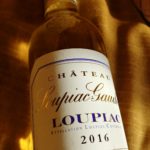 -2016 Château Loupiac-Gaudiet, Loupiac AOC, Bordeaux ($16 for a half bottle 375ml): 90% Sémillon and 10% Sauvignon Blanc. Again another fresher style sweet wine from the 2016 vintage with apricots and grilled pineapple that had hints of honey and only a touch of forest floor.
-2016 Château Loupiac-Gaudiet, Loupiac AOC, Bordeaux ($16 for a half bottle 375ml): 90% Sémillon and 10% Sauvignon Blanc. Again another fresher style sweet wine from the 2016 vintage with apricots and grilled pineapple that had hints of honey and only a touch of forest floor.
 -2015 Château La Rame Sainte-Croix-du-Mont, Sainte-Croix-du-Mont AOC, Bordeaux ($22 for a half bottle 375ml): 100% Sémillon. This is actually a well-known small producer among sommeliers in NYC, and probably other cities in the US that appreciate these wines. 2015 was a lusher, richer year which brings a real creaminess to this wine that would go great with avocado, as Mary Gorman-McAdams MW suggested, for perhaps those who want to stay away from meat. Also, crispy bacon in a BLT sounded amazing as well. Candied oranges seemed to dominate this wine for me with a lovely aroma of pressed flowers that had a sweet, mouth coating length that was lifted by mineral notes expressed on the finish.
-2015 Château La Rame Sainte-Croix-du-Mont, Sainte-Croix-du-Mont AOC, Bordeaux ($22 for a half bottle 375ml): 100% Sémillon. This is actually a well-known small producer among sommeliers in NYC, and probably other cities in the US that appreciate these wines. 2015 was a lusher, richer year which brings a real creaminess to this wine that would go great with avocado, as Mary Gorman-McAdams MW suggested, for perhaps those who want to stay away from meat. Also, crispy bacon in a BLT sounded amazing as well. Candied oranges seemed to dominate this wine for me with a lovely aroma of pressed flowers that had a sweet, mouth coating length that was lifted by mineral notes expressed on the finish.
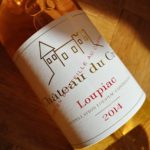 –2014 Château du Cros, Loupiac AOC, Bordeaux ($22 for a full size bottle 750ml): 90% Sémillon, 5% Sauvignon Blanc and 5% Muscadelle. 2014 was a year of high acidity and lots of savory notes that works out well for sweet wines. Yes, fierce acidity with smoky minerality and ripe peaches that had a flavorful yet zingy finish.
–2014 Château du Cros, Loupiac AOC, Bordeaux ($22 for a full size bottle 750ml): 90% Sémillon, 5% Sauvignon Blanc and 5% Muscadelle. 2014 was a year of high acidity and lots of savory notes that works out well for sweet wines. Yes, fierce acidity with smoky minerality and ripe peaches that had a flavorful yet zingy finish.
 –2011 Château Dauphiné-Rondillon, Loupiac AOC, Bordeaux ($16 for half bottle 375ml): 70% Sémillon and 30% Sauvignon Blanc. This is considered a great year for sweet Bordeaux wines so start grabbing them up. 2011 had high acidity and it was ideal for noble rot so they had tons of good, clean botrytis and these wines are meant for long-term aging although they taste great now! Preserved exotic oranges on honey drilled vanilla ice cream and grilled peaches with citrus zest on the finish.
–2011 Château Dauphiné-Rondillon, Loupiac AOC, Bordeaux ($16 for half bottle 375ml): 70% Sémillon and 30% Sauvignon Blanc. This is considered a great year for sweet Bordeaux wines so start grabbing them up. 2011 had high acidity and it was ideal for noble rot so they had tons of good, clean botrytis and these wines are meant for long-term aging although they taste great now! Preserved exotic oranges on honey drilled vanilla ice cream and grilled peaches with citrus zest on the finish.
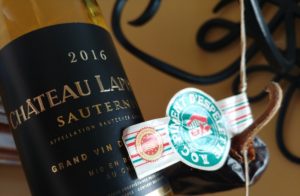 -2016 Château Lapinesse, Sauternes AOC, Bordeaux ($22 for half bottle 375ml): 100% Sémillon. Viscous texture that went so well with the beef jerky, with flavors of peach pie and roasted coconut with a long decadent finish that still had zing with orange zest. Despite it being a less concentrated year, the richness of the Sauternes AOC comes through.
-2016 Château Lapinesse, Sauternes AOC, Bordeaux ($22 for half bottle 375ml): 100% Sémillon. Viscous texture that went so well with the beef jerky, with flavors of peach pie and roasted coconut with a long decadent finish that still had zing with orange zest. Despite it being a less concentrated year, the richness of the Sauternes AOC comes through.
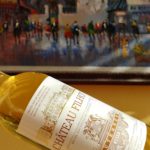 –2015 Château Filhot, Sauternes AOC, Bordeaux ($25 for half bottle 375ml): 60% Sémillon, 36% Sauvignon Blanc and 4% Muscadelle. Marmalade and piña colada with cloves and a long textural finish.
–2015 Château Filhot, Sauternes AOC, Bordeaux ($25 for half bottle 375ml): 60% Sémillon, 36% Sauvignon Blanc and 4% Muscadelle. Marmalade and piña colada with cloves and a long textural finish.
 –2006 Castelnau de Suduiraut, Sauternes AOC, Bordeaux ($20 for half bottle 375ml): 99% Sémillon and 1% Sauvignon Blanc. 2006 was a higher acidity year and quite difficult for producers yet the best pulled off some beautiful wines that will make wonderful old bones, especially for the sweet wines. This is the second wine of 1er Cru Classé Suduiraut and shows its evolution well with freshly dug truffles, dried porcini and coconut cream pie and orange blossom water on the expressive finish.
–2006 Castelnau de Suduiraut, Sauternes AOC, Bordeaux ($20 for half bottle 375ml): 99% Sémillon and 1% Sauvignon Blanc. 2006 was a higher acidity year and quite difficult for producers yet the best pulled off some beautiful wines that will make wonderful old bones, especially for the sweet wines. This is the second wine of 1er Cru Classé Suduiraut and shows its evolution well with freshly dug truffles, dried porcini and coconut cream pie and orange blossom water on the expressive finish.
Snacks Provided by Snooth to Pair with Wines:
My Favorites
-Jack Link’s Sweet & Hot Jerky
-Olli Calabrese Spicy Salami
Others
-Sweet Potato Crackers & Beet Crackers from Trader Joe’s
-Emerald Sriracha Cashews
-Wilde Jalapeño Chicken Chips
Sauternes AOC is the most famous of these golden Bordeaux but there are other AOCs we explored located either right across the river or literally next door to this legendary sweet wine area and benefit from the same noble rot creating factors such as Cadillac, Loupiac, Sainte-Croix-du-Mont which were all explored in this tasting. Many of you may wonder why Barsac was not included but since the AOC is as well known as Sauternes as well as many Barsac wines can be labeled Sauternes (since Sauternes is in the commune of Barsac) it seems like there was more of a focus on lesser known AOCs being compared with a couple of Sauternes producers.
These sweet golden wines are a blend of white grapes such as Sémillon (typically the majority or sometimes 100% varietal wine), Sauvignon Blanc and sometimes Muscadelle. Sémillon is ideal for noble rot (botrytis) as it is thin-skinned, develops a lush, waxy texture, expresses a wide range of complex aromas and flavors; Sauvignon Blanc gives fresh aromatics as well as high acidity; and the inconsistently used Muscadelle can add interesting spice to the wine.










